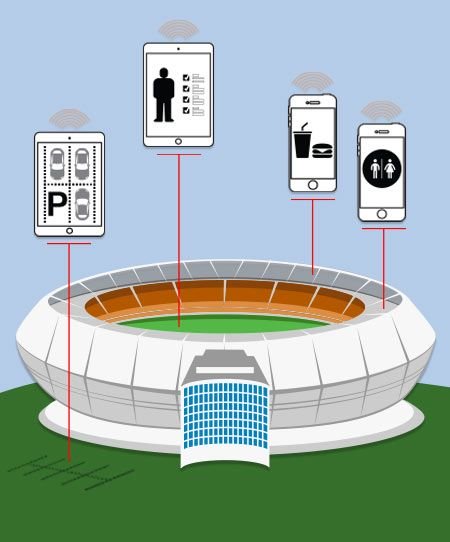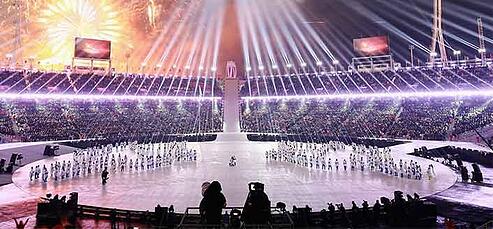To engineer these memorable experiences, host cities often leverage new technologies to heighten the action for fans. For example, the city of Pyeongchang, South Korea, host of the 2018 Winter Olympics, was the first to deploy wide-scale 5G connectivity for those who attended the games. With faster speeds and more reliable connectivity, audiences had instant access to a wealth of information regarding athletes and scores, plus the ability to record and relate their experiences through social media engagement.
Now, in the run up to the 2020 Summer Olympics in Tokyo, the Japanese government is taking further strides to enhance audience and athlete connectivity through the Internet of Things (IoT) while making sure that data remains secure.
Embracing the Smart Stadium
Nippon Telegraph and Telephone Group (NTT), the largest telecom operator in Japan, is a key technology provider for Tokyo 2020. In addition to deploying 5G connectivity through its mobile arm, NTT will handle network management, Wi-Fi, and other services for the organizers and 43 sports stadiums that will host the Olympics. For athletes, this means constant connectivity and support throughout the competition, from performance-tracking wearables to video conferencing with family and friends back home.
NTTs most lasting project, which aims to enhance the Olympic fan experience, is the development of smart stadiums. Smart systems are blanketed with wireless connectivity that enables high-quality streaming and real-time metrics for athletes and fans alike. Spectators with a stadium app can watch instant replays on their smartphones, panning the field at multiple angles to gain more insight into plays in real time. The same app can also measure concessions and restroom traffic so that fans can limit their time away from their seats, and even pre-order food for direct seat delivery. Using augmented reality, a fan can zoom in on a player to see a breakdown of their stats and current game performance.
Toyotas 5G Mascot Robot Assistants
One of the flashiest technological advancements at Tokyo 2020 will be a fleet of service robots specially developed by Toyota. The robots will welcome athletes and spectators to the games, provide support at venues, and enable remote participation access for those who are off-site.
Miraitowa and Someity, described as mascot-type robots, will be charged with greeting athletes and guests at games venues and making the experience more accessible for children. The T-HR3 Humanoid robot and T-TR1 robot will bring the games to remote locations and provide opportunities for spectators to interact through the robots displays. On the field, the Field Support Robot will assist at throwing events by self-navigating to retrieve items such as hammers and javelins thrown by the athletes and guiding staff along safe paths.
Aside from these four robot types, more robots will be on-hand to assist with everything from food delivery to accessibility for disabled attendees. All of these robots will understand multiple languages, and communicate and coordinate through NTTs 5G wireless network to provide support throughout the games.
Before the Games, the Japanese Government will Test Network Security
At the beginning of 2019, the Japanese government approved an amendment to stress test the security of their IoT infrastructure ahead of the Summer Olympics. This amendment allows employees of the National Institute of Information and Communications Technology (NICT) to hack citizens IoT devices to root out weaknesses in their security features.
According to a report from the Ministry of Internal Affairs and Communications Cyber-Security Office, two-thirds of the cyber attacks in Japan in 2016 targeted IoT devices. The heightened risk to connected devices at high-profile events like the Olympics has sparked a desire to mitigate risks with a heightened degree of urgency.
Per the amendment, NICT hackers will use default passwords and password dictionaries to attempt hacks of up to 200 million randomly-selected IoT devices. They will then compile a list of vulnerable devices and share this information with internet service providers, who will be expected to alert consumers and secure devices. With the sheer number of devices that will be networked and connected to cloud interfaces at the Olympics, these tests are seen as a necessary step to ensure that cybercriminals are prevented from stealing audience and athlete data for nefarious purposes.
Upgrade the Sporting Experience with Aeris
Tokyo 2020 is only the beginning for IoT-enhanced sporting events. From performance-measuring infrastructure that can enhance athletic training to a dynamic, interactive fan experience, IoT gives teams and fans the ability to take their game up a notch.
At Aeris, we provide connectivity solutions that make IoT enhanced experiences possible. Aeris offers customers unparalleled scalability and deployment across diverse networks anywhere in the world. Through the Aeris Intelligent IoT Network, coaches and stadium managers can easily provision devices and gain insights from device data in real time. No matter the application, Aeris can deliver results.
To learn more about how IoT can give your team the competitive edge and expand your fans game day experience, contact Aeris today.




